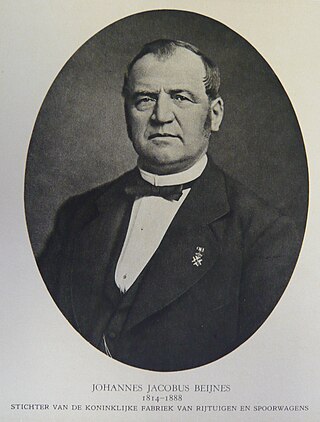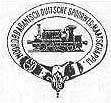
Haarlem is a city and municipality in the Netherlands. It is the capital of the province of North Holland. Haarlem is situated at the northern edge of the Randstad, one of the more populated metropolitan areas in Europe; it is also part of the Amsterdam metropolitan area. Haarlem had a population of 162,543 in 2021.

Metro-Cammell, formally the Metropolitan Cammell Carriage and Wagon Company (MCCW), was an English manufacturer of railway carriages, locomotives and railway wagons, based in Saltley, and subsequently Washwood Heath, in Birmingham. The company was purchased by GEC Alsthom in May 1989; the Washwood Heath factory closed in 2005 and was demolished in early 2019.

Haarlem railway station is located in Haarlem in North Holland, Netherlands. The station opened at September 20, 1839, on the Amsterdam–Rotterdam railway, the first railway line in the Netherlands. The station building itself is a rijksmonument.

Wolverton railway works, known locally as Wolverton Works or just The Works, was established in Wolverton, Buckinghamshire, by the London and Birmingham Railway Company in 1838 at the midpoint of the 112-mile-long (180-kilometre) route from London to Birmingham. The line was developed by Robert Stephenson following the great success of the Liverpool and Manchester Railway line.

The Railway Museum in Utrecht is the Dutch national railway museum. It was established in 1927 and since 1954 has been housed in the former Maliebaan station.

Trekschuit is an old style of sail- and horse-drawn boat specific to the Netherlands, where it was used for centuries as a means of passenger traffic between cities along trekvaarten, or tow-canals.

The Hollandsche IJzeren Spoorweg-Maatschappij or HSM was the first railway company in the Netherlands founded on 8 August 1837 as a private company, starting operation in 1839 with a line between Amsterdam and Haarlem. The company remained operational until 1938, when it merged with the Maatschappij tot Exploitatie van Staatsspoorwegen (SS) to form the Nederlandse Spoorwegen (NS).
Strømmens Værksted A/S was an industrial company based in Skedsmo, Norway, specialising in the production of rolling stock. Founded in 1873, it remains as a part of Bombardier Transportation. The plant is located just off Hovedbanen west of Strømmen Station.

Vocational School, Vakschool, Huishoudschool, or Ambachtsschool in Haarlem refers to set of Haarlem schools that conformed to a type of Dutch Junior High School based on practical training with the aim of obtaining employment. This type of school was discontinued with the 1968 law for further schooling called the Wet op het voortgezet onderwijs or Mammoetwet.

Johannes Jacobus, or J.J. Beijnes was a Dutch businessman and entrepreneur who, along with his brother Antonie Johannes (A.J.) Beijnes, was credited with growing the Haarlem factory Beijnes into an international manufacturer of train and tram wagons.

Werkspoor N.V. was the shortened, and later the official name of the Nederlandsche Fabriek van Werktuigen en Spoorwegmaterieel. It was a Dutch machine factory, known for rolling stock, (ship) steam engines, and diesel engines. It was a successor of the company Van Vlissingen en Dudok van Heel, later named Koninklijke Fabriek van Stoom- en andere Werktuigen. In 1954 Werkspoor was merged with Stork.

The Mat '24 was a series of electric "locomotives" of the Dutch Railways. After the arrival of electric streamline units in 1935, the name of this equipment became Blokkendozen, after the angular model. Some NS employees and those interested in the railway invariably spoke of "(electric) buffer equipment", to distinguish it from the streamlined, bufferless electric multiple units of the types Mat '35, Mat '36 and Mat '40.

The Noord-Brabantsch-Deutsche Spoorweg-Maatschappij (NBDS) was a railway company undertaking and providing rail transport between Boxtel and Wesel via Uden, Veghel, Gennep, Goch and Xanten. This railway was known in the Netherlands as "Duits lijntje ". On July 15, 1873, the section from Boxtel to Goch could be opened. On July 1, 1878, the second section of the line, the section from Goch to Wesel, could be opened. The total length of the line was 92.7 kilometers, of which 52.7 kilometers on Dutch territory. From Büderich, another 8.2 kilometers of the Köln-Mindener Eisenbahn was used, so was a part of the line from Venlo via Wesel to Haltern, Münster and Hamburg.

The Haarlem-Zandvoort Spoorweg Maatschappij (HZSM) was the first local railway company in the Netherlands, founded on November 29, 1880, in Amsterdam. This company built the Haarlem - Zandvoort railway, which was opened on June 3, 1881.

The NS 7100 was a series of tank engines of the Dutch Railways (NS) and its predecessors Maatschappij tot Exploitatie van Staatsspoorwegen (SS), Hollandsche IJzeren Spoorweg-Maatschappij (HSM) and Noord-Friesche Locaalspoorweg-Maatschappij (NFLS).

The NS 7700 was a series of tank engines of the Dutch Railways (NS) and its predecessor the Hollandsche IJzeren Spoorweg-Maatschappij (HSM).

The NS 1900 was a series of express train steam locomotives of the Dutch Railways (NS) and its predecessor Hollandsche IJzeren Spoorweg-Maatschappij (HSM).



















